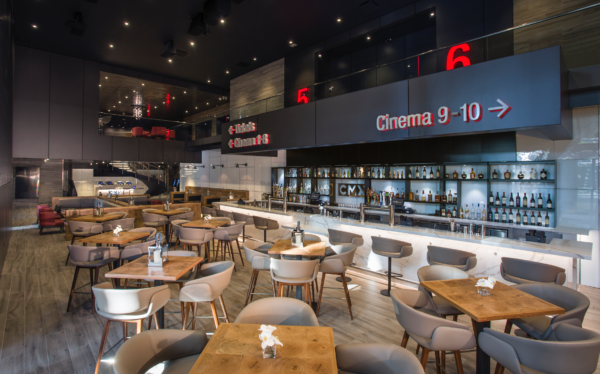This week on the Boxoffice Podcast, Luis Castelazo—CFO of CMX Cinemas, the U.S. arm of Mexican circuit Cinemex—elaborates on a December 2020 open letter in which he called for a change in the exhibition status quo: If the theatrical exclusivity shrinks, so will movie theater attendance, and thus so too should film rental fees. Below is a condensed version of the conversation with Castelazo, which can be listened to in full here or on your podcast service of choice.
It’s been an interesting start to 2021 as we’re all balancing what this recovery is going to look like. To get started, why don’t you tell us a little bit about CMX Cinemas? It’s a circuit that jumped onto the scene in the United States not that long ago and quickly rose to become one of the top 10 circuits in the market.
Correct. We got here in the U.S. in 2017. We opened our first location in Miami in Brickell City Centre. And from there we grew very quickly. We reached the 40 location mark last year. We have had lots of ups and down. We had to file Chapter 11. But thankfully, with the help of everyone on the team, we’re out of Chapter 11 and ready to continue operating here in the US..
I’ve had a chance to visit your location in New York City—I really do recommend it when theaters open back up. It’s a very luxurious cinema.
That’s the way we build all the new theaters. Whenever we remodel them, we do them with the same look and feel like the one in New York. I hate to break the news, but the New York City one was one of the ones we rejected during our Chapter 11. So that one is no longer ours. However, we do have many more throughout the country.
Your Miami location is fascinating. It really is one of those premier locations in the city. One of the things you did was adopt this concept of not only having to rely on the movie theater experience itself. You also added a sports bar to that Miami location. I believe it was called Stone?
That’s correct. Yes, we did that in Miami. It works really well. We’ve done the same with old and new ones that we’ve been building. People can go there not only to watch a movie, but also to enjoy a game or simply watch whatever is on TV at that moment.

In a city like Miami, you have a very diverse culture. You should see how the crowds get at the movie theaters during the World Cup. It’s interesting, because a World Cup summer is usually a down time for a lot of movie theaters around the world. CMX has also introduced some concepts that I find very interesting on the concession side. I believe you have that grab and go concessions food court—is it in your Closter, New Jersey location?
Correct. We have it there. We also have it in Illinois. Basically what we’re offering is higher-end food that you can get from a grab and go station, or from an actual station where it is prepared at the moment. Basically, it’s like a market—and actually the concept is called Markets. You take your things. You pay at the end. And you take them to your seat. It’s not the super highest-end like our CinéBistro concept, where we have the servers come to your seats and give everything to you. But it’s certainly a much higher-end experience than the regular concessions.
Have you integrated mobile ordering into that? Or is that something that that you’re looking into?
We’re working towards implementing this. Yes.
When CMX filed for Chapter 11 in 2020, it was notable because it was the first major circuit in the North American market to do so. And in that piece of news was an important detail that Luis would end up expanding on by the end of the year, which was: Film rentals and the economic structure of how things have to change in order for the industry to really get back up and running. CMX was a little bit on the forefront of realizing how big this crisis was going to be and that really, we had to have a recalibration and a radical realignment of how the industry works. Could you tell us a little bit about how the film business has traditionally worked for a major circuit like CMX?
Traditionally, in the U.S., the studios have always charged a percentage of movie ticket sales. That percentage has been going up. If we go back to the 70s and we research what that percentage was, that percentage was below 30 percent. So that means less than 30 percent of the ticket sales would go to the studios. The movie theaters were able to keep more than 70 percent. Studios, obviously, have the power to continue increasing that. Otherwise, if we don’t book their movies, we’re worse off.
So they have been able to increase this percentage through the years. And if you check out the public companies last year—or at least their U.S. operations—this percentage is 56, 57 percent of movie tickets. So what this has provoked is [that movie theaters]—they don’t have the margins that they used to. So they’ve had to try to get money from somewhere else. Generally, you’ve seen the movie theaters are maybe not as VIP an experience as you’ve seen in other countries. And this may be the reason: Movie theaters trying to save money and increase the price of food and beverage to be able to survive.
How does the film rental situation compare to the way things are in other countries?
Cinemex operates only in Mexico, where it also works as a percentage. Now, obviously, it’s confidential information, and I can’t comment on the percentages that they have there. You speak to anyone in the industry, and you’ll see that it varies by country. In the public companies, you will see that the operations of a single company in different countries, the percentage is different. A lot has been said also about changing the structure. It doesn’t make sense maybe anymore to have a percentage. Maybe it makes sense to have a set price or a per capita.
And I’ll give you an example. It’s not the same for someone who invests millions of dollars to have the best VIP offering—a great seat with with a lot of space—than someone who just crammed seats together and doesn’t offer anything else. In the end, if we are investing in offering a VIP experience, why do I have to share part of that with the studios? If someone watches a movie in my theater [versus] a theater that didn’t invest in in high end facilities, why do we have to pay more? The studio should be concerned about getting paid for each specific person that watches a movie and not take part of my big investment in putting VIP offerings in our facilities. That’s another thing that could change. But we’ll see what happens.
It’s an evolution of that same conversation that took place around the time of the conversion to digital. “Who pays for this?”
Exactly.

It’s really something we’ve seen with a lot of the international and multinational circuits coming into the U.S. market—something that I think we started to see 10, 15 years ago—where the standard of the movie theater experience in other countries started to slightly revitalize the way we were seeing movie theaters here in the U.S.. And those investments, as you note in your open letter, are significant. In other words, the investment for a movie theater is significantly more than an investment for a bar or a restaurant. And when you are facing a split or a percentage of your admissions revenues that is continuously smaller and smaller on your end for the studios, that can get difficult. In that open letter, you mentioned a couple of solutions that you thought would be viable for exhibition to get back on its feet. I was wondering if you could take us through those proposals and how they could work.
The studios have historically given us a window, or a number of days in which we have exclusivity before they release their movies elsewhere. Namely, their online apps. Because we have been given this exclusivity window, they have been able to charge a very high percentage. Now, if today they decide to reduce that window or to eliminate that window completely, then they can’t possibly charge the same. Because, obviously, our attendance will drop.
So what I did in this open letter—specifically for CMX—was to calculate more or less what this percentage should be when we have less attendance because of these decisions that [studios are] making. So if our attendance is reduced by 50 percent, then the percentage that they have to charge us is very similar to what they were charging us in the 70s, if we want to maintain the same profitability. So that’s that’s basically the proposal. If we’re not having that historical exclusivity, then the percentage that they charge us for every movie should be drastically reduced. And the reduction should be calculated based on how much our attendance is impacted, versus having that exclusivity that we have enjoyed for several decades.
CMX has done that analysis to determine what the drop in attendance would be if a movie goes day-and-date or if its exclusivity window is shortened drastically. And you say that film rental should be adjusted to reflect that drop. But how do you determine what the drop is going to be? And how can you say what it was caused by? The studio could come back and say, ‘No, this drop isn’t because of streaming. It’s because of something to do with the theater or something to do with the movie itself.‘
Thankfully, we have a lot of data from the past. Whenever we have a new movie, there are movies that are similar that we can compare to. That’s the way it’s always been done. Of course, the forecasts of box office in the United States or of attendance in the United States are not always perfect. But they have been somewhat reliable. We have been able to predict—and I say “we” as in “the industry”—how much box office we’ll be able to produce. My conclusion is that just as we have been able to forecast to some extent how each movie will do, we should be able to come with a good expectation of range of how much it would do if it weren’t sent to a streaming platform. And how much it actually did if it is sent to a streaming platform earlier or at the same time as in movie theaters. It is not perfect. But so far, we’ve been able to do a fairly good job, historically,
What’s notable about this is it that it implies, from the exhibition side, a flexibility on the windows conversation, which has been a very fraught conversation for many decades in this industry. I’ve heard it from many exhibitors: “Okay, if there is this push to shorter windows, we have to restructure how everything is working so the system can still survive with a shorter windows.” It’s not as the conversation used to go: “Shorter windows are a non-starter.” In your experience, have studios been amenable at looking at restructuring these arrangements? Or are we so early in the conversation that it’s a little bit of that Warner Bros. situation, where something is announced, and the details really haven’t been worked out yet?
I would say it’s more the latter. We’ve had conversations, even before the pandemic. Everyone is looking into how things are going to settle down and who does the first move. It’s not like we’ve been able to arrange any kind of new deals. But we hope that we can work and make these new arrangements, which will save the industry and also help the studios. We’re not opposed, at least speaking for CMX, to having the windows being reduced or eliminated. But what we need is a different kind of film rental that is fair for both parties.
When it comes to shortened windows, obviously, it’s very early days, and the number one factor affecting attendance is Covid, not streaming. That said, regarding Wonder Woman 1984: Looking at how things have been at CMX or maybe in discussions with other exhibitors, have you gotten the sense that the day-and-date release of the film affected theatrical attendance at all?
When it was released, the first week was really, really good. Taking into account that we’re in the middle of the pandemic, of course. Because of the pandemic, what happened is that the people who are really, really hard fans of the movie are the ones who went on the first week. Usually when we have a blockbuster such as that one, the number of people attending keeps being high for the next couple of weeks. But that’s not during a pandemic. During a pandemic, of course, things change. As you know, we have a restricted number of seats we can sell depending on the state and county. It is very difficult to know what would have happened if there wasn’t a pandemic. With a movie being released in an online platform at the same time as in theaters, it’s difficult to know what would have happened.
We are looking at this year as a recovery year for the cinema industry. What does that recovery mean for you? And when do you think—maybe not specifically when audiences will be able to come back without restrictions—but how much do you believe this industry can recover with shortened windows? Are we going to have that $11 billion streak that we had in North America once again? Or with shorter windows, are we looking at potentially a smaller market?
I wish I could answer that and know exactly what’s going to happen. My take is that most of the studios have pushed their big movies to the future. They have simply postponed them. It’s only a handful that they decided to send to streaming platforms. I would say in the short term, the next two or three years, once we’re out of the pandemic—they should be very good years. And we should get back to normal, despite shortening windows. Because I believe we’re going to have a lot of offerings out there.
Now, what will happen beyond that, I think it is difficult to know. But the with fact that there will be so many offerings in so many different platforms and on movie theaters, I think people are just going to have too many options to watch a movie. But just as people have too many options to go to a restaurant, instead of dining at home, you still want to go to a restaurant. So I believe there’s still going to be a market for people to enjoy movies on the big screen and to be able to have something else that maybe they can’t have at home. In our case, the CMX Stone sports bar or VIP facilities. So I’m not sure if the industry will be as large as it has historically been or it will be smaller. But what I do know is that the industry will still be here for many years to come.



Share this post